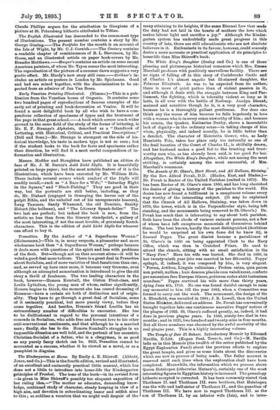The Annals of St. Olave's, Hart Street, and All Hallows,
Staining.' By the Rev. Alfred Povah, D.D. (Blades, East, and Blades.)— Dr. Povah is Rector of the United Parishes (united in 1870). He has been Rector of St. Olave's since 1860, and has long cherished the desire of giving a history of the parishes to the world. His desire has now found a fulfilment in a sumptuous volume every way worthy of the interesting subject. (It may be explained that the Church of All Hallows, Staining, was taken down in 1870, the tower, which is in the Perpendicular style, being left standing, and the monuments being removed to St. Olave's.) Dr. Povah has much that is interesting to say about both parishes. Both have been the abode of various eminent persons, not a few of whom hate left sumptuous memorials of themselves behind them. The best known, hardly the most distinguished (doubtless he would be surprised at his own fame did he know it), is Samuel Pepys. The great diarist became a parishioner of St. Olave's in 1660 on being appointed Clerk to the Navy Office, which was then in Crutched Friars. He used to attend the church, sitting with no small satisfaction in the "Navy Pew." Here his wife was buried. She died in 1669, in her twenty-ninth year (she was married in her fifteenth). Pepys' epitaph, if, indeed, it was composed by him, is very elegant. "Forma, Artibus, Linguis cultissima ; Prolem enixa, quia parem non potuit, nullam ; hub c demum placide cum valedixerat, coafecto per amoeniora fore Europae itinere, potiorem redux abiit lustratnra mundum." Pepys survived his wife more than thirty years, dying June 4th, 1703. No one was found dutiful enough to raise any memorial to him till the year 1882, when a Committee was formed to carry out the work. The monument, the design of Sir A. Blomfield, was unveiled in 1884; J. R. Lowell, then the United States Minister, delivered an address. Dr. Povah has conveniently brought together into one continuous narrative Pepys' notices of the plague of 1665. St. Olave's suffered greatly, as, indeed, it had done in previous plague years. In 1563, ninety-two died in two months ; and in 1625, two hundred and twenty-nine in four months. But all these numbers was obscured by the awful mortality of the real plague year. This is a highly interesting volume.


































 Previous page
Previous page